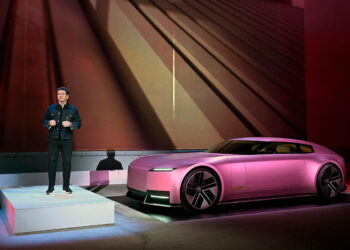In a surprising twist, Alfa Romeo might not go all-electric by 2027 as previously promised. Jean-Philippe Imparato, the outgoing CEO of the iconic Italian marque, dropped a bombshell during the Paris Motor Show, suggesting that internal combustion engines (ICE) could be part of Alfa’s future lineup longer than expected.
Back in August 2021, Stellantis, Alfa’s parent company, boldly announced that Alfa Romeo would shift entirely to electric vehicles (EVs) in key markets like Europe, North America, and China by 2027. However, Imparato’s recent comments point toward a more flexible strategy, especially with Santo Ficili set to take the reins as CEO.
According to Imparato, Ficili has the freedom to adapt Alfa’s approach depending on market conditions. In particular, the upcoming fully electric versions of the Stelvio SUV and Giulia sedan might not be the only options for buyers. If EV sales don’t meet expectations, Alfa could continue to offer gasoline-powered versions of these models, thanks to the versatile STLA Large platform.
This platform, which will underpin the next-generation Stelvio (due in 2025) and Giulia (expected in 2026), is designed primarily for electric vehicles but can also accommodate ICEs. It’s already used by Dodge for the new Charger, which offers a powerful twin-turbo 3.0-liter inline-six engine with up to 550 horsepower. The flexibility of this platform means that Alfa Romeo could easily switch between EV and gas-powered models depending on market demand.
Alfa’s shift to the STLA Large platform marks the end of the Giorgio platform, which was used exclusively for the current Stelvio and Giulia, along with a few Maserati models like the Grecale and GranTurismo. By adopting STLA Large, Alfa Romeo is aligning itself with other Stellantis brands like Dodge, Chrysler, and Maserati, all of which will produce future models using the same underpinnings.
But the possibility of continuing with gas-powered models may indicate a broader trend in the automotive industry. Imparato’s suggestion that ICE could remain in Alfa’s lineup reflects a growing sentiment among automakers that transitioning to EVs might not be as quick or seamless as initially predicted. Nearly all major car manufacturers who had vowed to switch to fully electric vehicles by 2030 have recently adjusted their timelines, largely due to slow consumer adoption, supply chain challenges, and political pressures.
In fact, there’s mounting pressure on the European Union to delay the planned 2035 ban on the sale of new ICE vehicles. If Alfa Romeo keeps gas-powered models, it would join a growing list of automakers scaling back their ambitious EV goals.
As Alfa Romeo looks ahead, it’s not just the future of the Stelvio and Giulia that’s under consideration. Imparato also confirmed that a larger SUV is set to debut in 2027, aimed primarily at the North American market. Like the Stelvio and Giulia, this flagship model will sit on the STLA Large platform, meaning gas-powered options could be on the table.
If Alfa continues down this path, it could mark a significant shift in the company’s strategy—one that balances the need for innovation in the electric space with the continued demand for powerful, performance-oriented gasoline engines that have been part of the brand’s DNA for decades.
For now, Alfa Romeo’s EV revolution might be on hold, but the storied Italian automaker isn’t ruling out the roar of combustion engines just yet.










